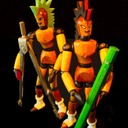Yop,
this thesis (http://www.tesisenred.net/bitstream/handle/10803/7264/TAPC.pdf?sequence=1) explains a method for reconstructing a body impulse response (BIR) characterizing the passage from a piezo pickup on a violin to the sound recorded from a mic in an anechoic chamber of the same violin. A slow and long glissando is recorded in parallel from pickup and microphone, and the BIR is calculated. The violin pickup sound can then been convoluted to render a more realistic sound, simulating the miking. Hear samples here : http://www.dtic.upf.edu/~aperez/JASAradiation/
I already started trying to make it with Pd, but I'm not sure it will be possible (besides maximum buffer length discussed in topics like http://puredata.hurleur.com/sujet-4189-swept-sine-deconvolution ). Once the real and complex parts from [rfft~] are stored in buffers, I guess it will be possible to make the weighted sum and other calculations. Should be easier to do that in C or something! Another concern is that I'm not sure to fully understand what does mean (page 96(114)) "An important issue for computing the average is that, since we are working in a bin-by-bin estimation, we must take into account the effects of the window applied to the signals. This fact led us to weight each bin estimation by the energy contribution of the corresponding bin in the input signal spectrum, so that frames for which the energy is low for the bin under estimation (more likely to be affected by window sidelobes) give less influence to the average".
I think that implies to define a relative energy seen from the frame point of view, am I right ? If it's not the case, I'd say that (if a and b are the real and imaginary parts of [rfft~]) magnitude would be the square root of energy (sqrt(a²+b²)), but this energy is not seen as a relative value but absolute.
What do you think of it all?
Of course this topic is not only related to violin, as this procedure is adapted from other works with guitars. See This thesis (http://www.google.be/url?sa=t&rct=j&q=&esrc=s&source=web&cd=1&ved=0CC0QFjAA&url=http%3A%2F%2Fmtg.upf.edu%2Fsystem%2Ffiles%2Fpublications%2FBuccci-Andres-Master-thesis-2011_0.pdf&ei=bNBZUvvCBPON0wWyi4D4DA&usg=AFQjCNHwZ0JDaVCOcIOZZvzINL3rBMw5RA&bvm=bv.53899372,d.d2k). I stumbled upon this material following shawnb links in this topic (http://puredata.hurleur.com/sujet-9637-guitar-effects-designing-hardware), thank you again. Look at the videos on http://www.futureguitarnow.com/forum/index.php?topic=1945.0 . These guys use some softs to get impulse responses playing riffs along their beloved guitar hero and convolve their guitar, even with an arduino ! Inspiring. As is this : http://www.weinreichlabs.com/
Sorry for the long post,
Thanx,
Nau


 I'm stuck !
I'm stuck ! )
)